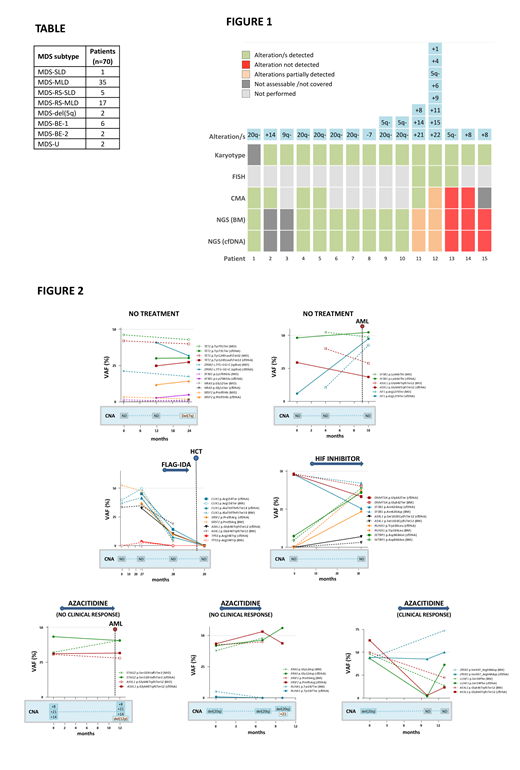Abstract
Introduction. Myelodysplastic syndromes (MDS) are clonal heterogeneous disorders in which molecular studies and cytogenetics are essential for diagnosis, classification and prognosis. Cell-free DNA (cfDNA) analysis has been reported as a reliable non-invasive approach for detecting molecular abnormalities in MDS. However, there is limited information about cytogenetic alterations and monitoring in cfDNA from MDS patients.
Objective. To assess and monitor the molecular and cytogenetic abnormalities by next generation sequencing (NGS) using cfDNA from patients with MDS.
Patients and methods. Bone marrow (BM) aspirates and peripheral blood (PB) samples were collected from 70 newly diagnosed or treatment-naïve patients with MDS (Table). PB samples from 21 healthy controls were also studied. Molecular characterization was performed in paired samples of BM DNA and cfDNA by NGS in all patients. Libraries were prepared using a custom panel including 48 myeloid-associated genes and genomic regions localized at the most frequently altered chromosomes in MDS (QIAseq Custom DNA Panels, Qiagen) and sequenced using Illumina. 20/70 (28.6%) showed cytogenetic/FISH alterations at diagnosis, 2 of them with infrequent alterations in MDS, not covered by the panel (+14, del(9q)). 6 cases presented chromosome Y loss as a single alteration, not covered by the NGS panel. Copy number variant (CNV) analysis was performed by NGS to detect cytogenetic alterations in both cfDNA and BM, and confirmed by chromosomal microarrays (CMA) in BM DNA (CytoScan/OncoScan, ThermoFisher).
Results. We obtained a median amount of cfDNA of 58.4 ng/ml in MDS patients that was significantly higher than that obtained in healthy controls (median 32.4 ng/ml, P=0.023). Sequencing of BM DNA and cfDNA showed a comparable mutational profile (187/201 mutations, 93.0% concordance). The most frequently mutated genes were TET2 (44.3%), SF3B1 (37.1%), ASXL1 (20.0%), DNMT3A (20.0%), SRSF2 (15.7%), ZRSR2 (12.9%) and U2AF1 (12.9%). A strong correlation was observed between the VAFs of BM DNA and cfDNA (r s=0.797, P<0.001). VAFs of SF3B1 mutations detected in cfDNA were significantly higher than VAFs in BM DNA (P=0.016).
The analysis of cytogenetic alterations by NGS showed abnormalities in 10/70 MDS patients in both BM DNA and cfDNA. Interestingly, in a patient without analyzable metaphases in karyotype, del(20q) was found by NGS and confirmed by CMA. Overall, CMA and NGS were highly concordant to detect chromosomal aberrations although they do not reach the sensitivity achieved by karyotype/FISH (Figure 1). However, all cytogenetic aberrations detected by NGS in BM DNA were also detected in cfDNA.
Molecular and cytogenetic alterations were monitored in sequential samples from 7 cases (median follow up: 13 months, range 10-30). We observed an excellent correlation between the VAF of mutations in BM DNA and ctDNA across multiple matched time points. A decrease in the VAF was detected in patients responding to therapy (either hypomethylating agents or chemotherapy), but not in non-responding patients (Figure 2). Of note, cfDNA analysis also showed cytogenetic evolution in 2 cases not responding to azacitidine (del(12p) and +21). From the two untreated patients, one acquired a subclonal del(7q) not detected by NGS and observed only in few metaphases, and the second patient showed a clonal expansion of the NF1 mutation at the time of AML transformation.
Conclusions. Analysis of cfDNA allows the characterization and monitoring of molecular abnormalities in patients with MDS. Cytogenetic alterations were detectable in most cases by NGS in both BM DNA and cfDNA although with a lower detection rate than karyotype/FISH.
Acknowledgements. ISCIII-FEDER, PI16/0153, PI19/0005, 2017SGR205, PT20/00023 and XBTC.
Figure/Table legends:
Table. MDS patients included, classified by disease subtype. (SLD: single lineage dysplasia; MLD: multilineage dysplasia; RS: ring sideroblasts; EB: excess blasts; MDS-U: MDS-unclassifiable)
Figure 1. Detection of cytogenetic alterations by conventional karyotype, FISH, CMA and NGS.
Figure 2. Monitoring of molecular and cytogenetic alterations in 7 patients with MDS. 5 patients receiving treatment (3 azacitidine, 1 FLAG-IDA + HCT, 1 inhibitor of hypoxia-inducible factor (HIF)) and 2 untreated cases were included. BM VAF dynamics are shown with a dotted line and cfDNA dynamics are shown with a solid line.
Besses: Gilead: Research Funding. Salar: Janssen: Consultancy, Speakers Bureau; Roche: Consultancy, Speakers Bureau; Gilead: Research Funding; Celgene: Consultancy, Speakers Bureau. Bellosillo: Thermofisher Scientific: Consultancy, Speakers Bureau; Roche: Research Funding, Speakers Bureau; Qiagen: Consultancy, Speakers Bureau.


This feature is available to Subscribers Only
Sign In or Create an Account Close Modal